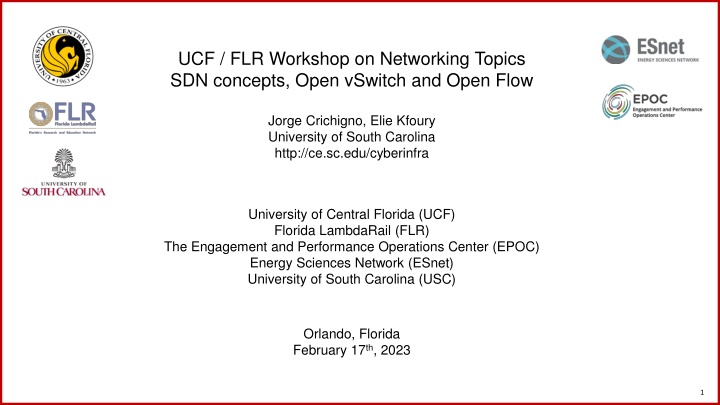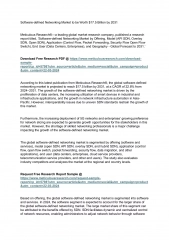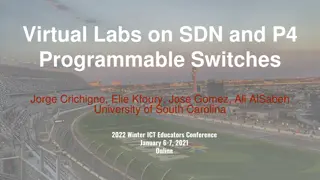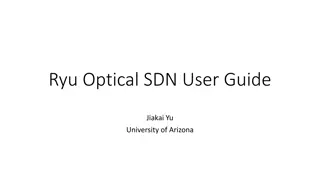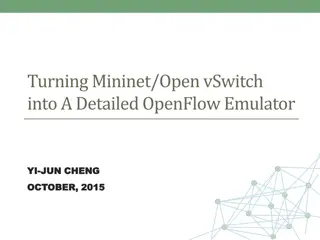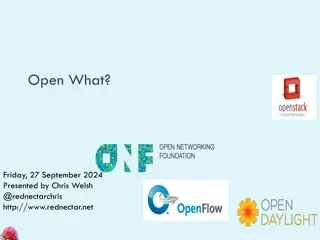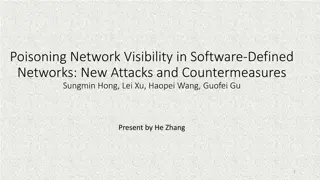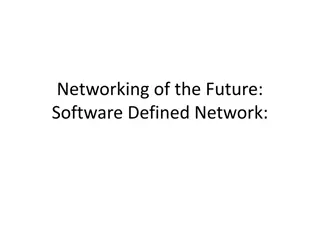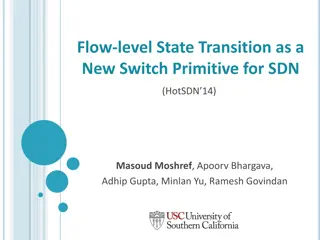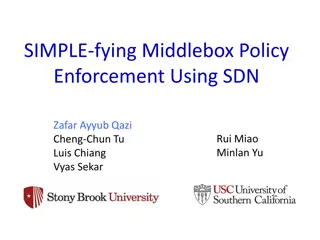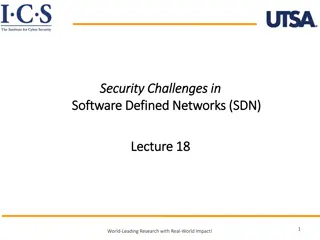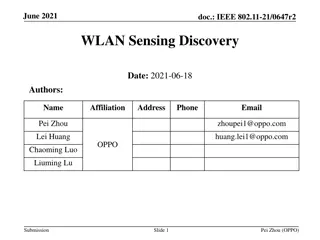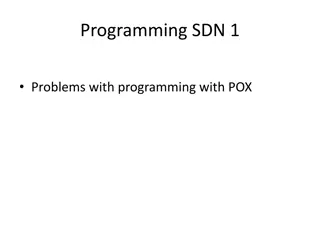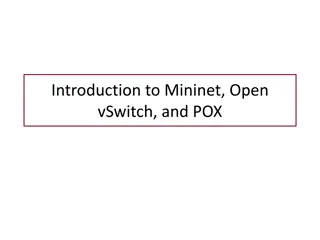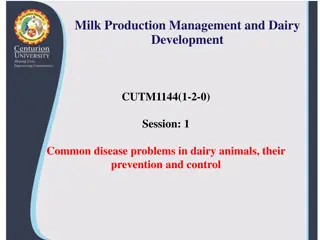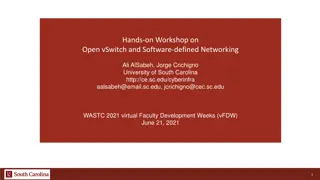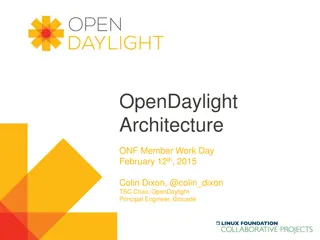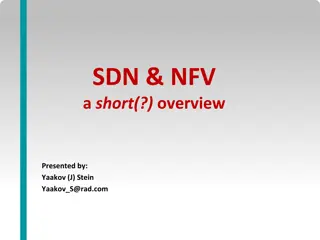Workshop on Networking Topics: SDN Concepts and Open VSwitch
This workshop delves into essential networking topics, covering SDN fundamentals, data and control planes, OpenFlow protocol, and limitations. Explore the concept of plane separation in SDN, including the data plane for forwarding functions and the control plane managed by a centralized controller. Understand the basic components of SDN operation, such as switches like Open vSwitch, controllers, and applications. Discover how SDN works to revolutionize network management and efficiency.
Download Presentation

Please find below an Image/Link to download the presentation.
The content on the website is provided AS IS for your information and personal use only. It may not be sold, licensed, or shared on other websites without obtaining consent from the author.If you encounter any issues during the download, it is possible that the publisher has removed the file from their server.
You are allowed to download the files provided on this website for personal or commercial use, subject to the condition that they are used lawfully. All files are the property of their respective owners.
The content on the website is provided AS IS for your information and personal use only. It may not be sold, licensed, or shared on other websites without obtaining consent from the author.
E N D
Presentation Transcript
UCF / FLR Workshop on Networking Topics SDN concepts, Open vSwitch and Open Flow Jorge Crichigno, Elie Kfoury University of South Carolina http://ce.sc.edu/cyberinfra University of Central Florida (UCF) Florida LambdaRail (FLR) The Engagement and Performance Operations Center (EPOC) Energy Sciences Network (ESnet) University of South Carolina (USC) Orlando, Florida February 17th, 2023 1
Agenda SDN fundamentals data and control planes SDN operation Flow / Forwarding tables OpenFlow protocol Limitations of SDN and OpenFlow 2
Plane Separation The first fundamental characteristic of SDN is the separation of planes Data plane, implemented in the device Control plane, implemented by a centralized controller Traditional network SDN network W. Stallings, Foundations of Modern Networking: SDN, NFV, QoE, IoT, and Cloud Addison Wesley, 2017. 3
Plane Separation Data Plane The data plane implements forwarding functionality (logic and tables for choosing how to deal with incoming packets) Forwarding based on MAC address, IP address, VLAN ID, etc. Dropping, replicating an incoming packet Traditional networks W. Stallings, Foundations of Modern Networking: SDN, NFV, QoE, IoT, and Cloud Addison Wesley, 2017. 4
Plane Separation Data Plane Special-case packets (e.g., routing advertisements) that require processing by the control plane are passed to that plane Traditional networks W. Stallings, Foundations of Modern Networking: SDN, NFV, QoE, IoT, and Cloud Addison Wesley, 2017. 5
Plane Separation Control Plane The control plane is moved off the switching device, onto a centralized controller The algorithms used to program the data plane (populate tables) reside in the control plane (e.g., OSPF, BGP) Traditional networks W. Stallings, Foundations of Modern Networking: SDN, NFV, QoE, IoT, and Cloud Addison Wesley, 2017. 6
SDN Operation Basic components (bottom-up) SDN switches (e.g., Open vSwitch) Controller (e.g., ONOS controller) Applications (e.g., BGP app, IDS app) Global view app BGP app Business app IDS app Northbound (REST, JSON) Control plane SDN Controller Data plane Southbound (OpenFlow) Flow table 7 How SDN Works
SDN Operation Switches SDN devices contain forwarding functionality Forwarding information is stored in flow tables If it does not find a match, it can either drop the packet or pass it to the controller Global view app BGP app Business app IDS app Northbound (REST, JSON) Control plane SDN Controller Data plane Southbound (OpenFlow) Flow table 8 How SDN Works
SDN Operation Controller SDN controller implements control plane functionality It presents an abstraction of the network to the SDN applications running above It allows the SDN applications to define flows on devices It maintains a view of the entire network (global network view) Global view app BGP app Business app IDS app Northbound (REST, JSON) Control plane SDN Controller Data plane Southbound (OpenFlow) Flow table 9 How SDN Works
SDN Operation Applications SDN applications are built on top of the controller Software applications can implement forwarding, routing, overlay, multipath, access control, etc. Application are driven by events coming from the controller and from external inputs Global view app BGP app Business app IDS app Northbound (REST, JSON) Control plane SDN Controller Data plane Southbound (OpenFlow) Flow table 10 How SDN Works
Forwarding Tables The interface between the control and data planes has been historically proprietary Vendor dependence: slow product cycles of vendor equipment, standardization Legacy network 11
Forwarding Tables In SDN networks, that function is now performed by the controller The controller is responsible for programming packet-matching and forwarding rules Legacy network SDN network 12
Advantages of SDN Networks vs. Legacy Networks Ease of network management Morecustomized network behavior Possibility of experimentation and innovation (custom policies, apps can be deployed) Packets can be forwarded based on other fields, such as TCP port number Legacy network SDN network 13
Overview of OpenFlow OpenFlow is a protocol specification that describes the communication between OpenFlow switches and an OpenFlow controller The consortium responsible for the OpenFlow specification is the Open Networking Foundation (ONF), which was created in 2011 SDN network 14
Overview of OpenFlow A switch receives packets on one port and forward it through another Example: port 2 -> port N Potential actions (A) Forward the packet out a local port (B) Drop the packet (C) Pass the packet to the controller via a PKT_IN message When the controller has a data packet to forward out through the switch, it uses the PACKET_OUT message (e.g., route advertisements) 15
Overview of OpenFlow The protocol consists of a set of messages from the controller to the switch and a corresponding set of messages in the opposite direction Basic ops: defining, modifying, and deleting flows 16
Overview of OpenFlow The secure channel is the path used for communications between the OpenFlow controller and the OpenFlow device This communication is secured by TLS-based encryption, though unencrypted TCP connections are allowed Connections may be in-band or out-of-band 17
Overview of OpenFlow Flow Table The flow table lies at the core of the definition of an OpenFlow switch A flow table consists of flow entries A flow entry consists of header fields, counters, and actions associated with that entry 18
Overview of OpenFlow Flow Table The header fields are used as match criteria The counters are used to track statistics relative to this flow, such as how many packets have been forwarded or dropped for this flow The actions fields prescribe what to do with a packet matching this entry 19
Overview of OpenFlow Flow Table The header fields are used as match criteria The counters are used to track statistics relative to this flow, such as how many packets have been forwarded or dropped for this flow The actions fields prescribe what to do with a packet matching this entry Flow table, switch s1 20
Overview of OpenFlow Each message between controller and switch starts with the OpenFlow header The header specifies the OpenFlow version, message type, message length, and transaction ID of the message Three categories Symmetric: sent by controller or switch w/o solicitation Controller-switch: sent by controller to switch Async: sent by switch to controller when there is any state change in the system 21
Overview of OpenFlow Example: Controller Programming (populating) Flow Table At ta, the controller sends a FLOW_MOD (ADD) command A flow is added for packets entering the switch on any port Source IP: 192.168.1.1 Destination IP: 209.1.2.1 Source TCP port: 20 Destination TCP port: 20 All other match fields have been wildcarded The outport port is specified as P 22
Overview of OpenFlow Example: Controller Programming (populating) Flow Table A packet arrives at the switch through port 2 with source IPv4 192.168.1.1 and destination IPv4 209.1.2.1 The packet-matching function scans the flow table starting at flow entry 0 and finds a match in flow entry F Flow entry F stipulates that a matching packet should be forwarded out port P 23
OpenFlow Additions The OpenFlow interface started simple, with few protocols that could be matched against incoming packets Over few years, the specification has been extended with many more header fields and new protocols Version Date Header fields OpenFlow 1.0 Dec. 2009 12 (Ethernet, TCP, IPv4) OpenFlow 1.1 Feb. 2011 15 (MPLS, ) OpenFlow 1.2 Dec. 2011 36 (ARP, ICMP, IPv6, ) OpenFlow 1.3 Jun. 2012 40 OpenFlow 1.4 Oct. 2013 41 OpenFlow 1.5 Mar. 2015 44 Bossart et al. P4: Programming Protocol-Independent Packet Processors OpenFlow Switch Specs v1.5.1. Online https://tinyurl.com/y4j4a5eh 24
Limitations of SDN / OpenFlow SDN Fixed number of header fields OpenFlow repeatedly extends the specification Long standardization cycles Fixed protocols / header fields Fixed parser Devices still in control of manufacturers Operators / programmers limited to functionality specified in the OpenFlow specification Match+action stages are in series P4 switches (see p4.org) Operators / programmers can define their own protocols and header fields Immediate implementation Customized protocols / header fields Devices in control of operators / programmers Match+action stages are in series or in parallel Actions are composed of protocol-independent primitives (switch is not tight to specific protocols) More future-proof 25
Programmable Switch ASICs We now have the technology that permits CI engineers to run customized functions CI Engineer Switch P4 Code CPU-based control plane Control Plane compiler Data Plane Programmable parser, tables, arithmetic logic units (ALUs), programmable deparser, Switch ASIC 26
Programmable Switch ASICs We now have the technology that permits CI engineers to run customized functions Designed for packet processing operations CI Engineer Switch P4 Code CPU-based control plane Control Plane compiler Data Plane Programmable parser, tables, arithmetic logic units (ALUs), programmable deparser, Switch ASIC 27
Programmable Switch ASICs We now have the technology that permits CI engineers to run customized functions Designed for packet processing operations Much faster than general-purpose CPUs for processing packets N. McKeown, Creating an End-to-End Programming Model for Packet Forwarding, Netdev 0x14 Conference 2020, https://www.youtube.com/watch?v=fiBuao6YZl0&t=619s. 28
Workshop on Networking Topics Webpage with PowerPoint presentations: http://ce.sc.edu/cyberinfra/workshop_2023_feb.html Hands-on sessions: to access labs for the hands-on sessions, use the following link: https://netlab.cec.sc.edu/ Username: email used for registration Password: nsf2023 29
